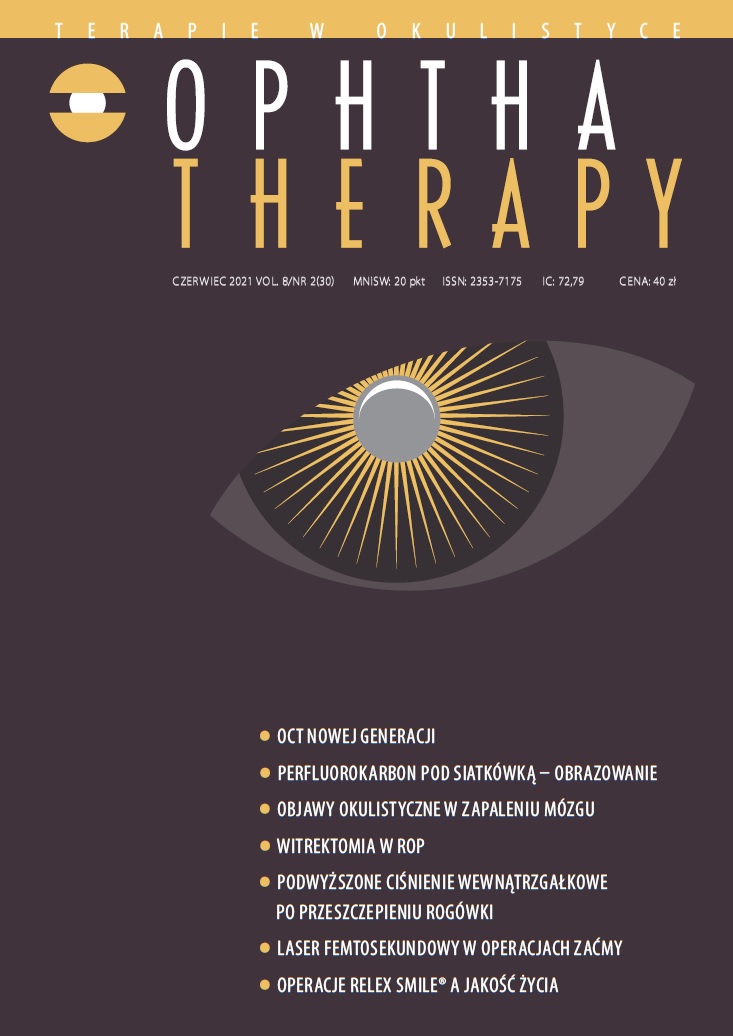The mechanism of intraocular pressure rise after keratoplasty Case series report
Main Article Content
Abstract
Purpose: To determine the pathomechanism of increased intraocular pressure after penetrating and lamellar keratoplasty based on clinical observation and literature data.
Materials and methods: Morphometric analysis of the anterior segment of the eye using spectroscopic optical coherence tomography, gonioscopy and biomicroscopy.
Results: Pre- and postoperative spectroscopic optical coherence tomography scans in patients after keratoplasty reveal deformation of the peripheral cornea, narrowing of the iridocorneal angle, presence of anterior synechiae and various types of pupillary block.
Conclusions: The mechanism of elevated intraocular pressure after corneal grafting is complex and depends on pre-, intra- and postoperative factors, such as anatomy changes of the iridocorneal angle, presence of anterior synechiae, as well as anterior and posterior pupillary block. Spectroscopic optical coherence tomography plays an important role in diagnosis and further treatment management.
Downloads
Article Details

This work is licensed under a Creative Commons Attribution-NonCommercial 4.0 International License.
Copyright: © Medical Education sp. z o.o. License allowing third parties to copy and redistribute the material in any medium or format and to remix, transform, and build upon the material, provided the original work is properly cited and states its license.
Address reprint requests to: Medical Education, Marcin Kuźma (marcin.kuzma@mededu.pl)
References
2. Czerwiński J (ed). Biuletyn Informacyjny. Centrum Organizacyjno-Koordynacyjnego ds. Transplantacji Poltransplant. 2019: 45-6.
3. Reinhard T, Kallmann C, Cepin A et al. The influence of glaucoma history on graft survival after penetrating keratoplasty. Graefes Arch Clin Exp Ophthalmol. 1997; 235(9): 553-7.
4. Irvine AR, Kaufman HE. Intraocular pressure following penetrating keratoplasty. Am J Ophthalmol. 1969; 68(5): 835-44.
5. Wilson SE, Kaufman HE. Graft failure after penetrating keratoplasty. Surv Ophthalmol. 1990; 34(5): 325-56.
6. Ayyala RS. Penetrating keratoplasty and glaucoma. Surv Ophthalmol. 2000; 45(2): 91-105.
7. Seitz B, Langenbucher A, Nguyen NX et al. Long-term follow-up of intraocular pressure after penetrating keratoplasty for keratoconus and Fuchs’ dystrophy: comparison of mechanical and Excimer laser trephination. Cornea. 2002; 21(4): 368-73.
8. Greenlee EC, Kwon YH. Graft failure. III. Glaucoma escalation after penetrating keratoplasty. Int Ophthalmol. 2008; 28(3): 191-207.
9. Foulks GN. Glaucoma associated with penetrating keratoplasty. Ophthalmology. 1987; 94(7): 871-4.
10. Dada T, Aggarwal A, Minudath KB et al. Post-penetrating keratoplasty glaucoma. Indian J Ophthalmol. 2008; 56(4): 269-77.
11. Vajaranant TS, Price MO, Price FW et al. Visual acuity and intraocular pressure after Descemet's stripping endothelial keratoplasty in eyes with and without preexisting glaucoma. Ophthalmology. 2009; 116(9): 1644-50.
12. Espana EM, Robertson ZM, Huang B. Intraocular pressure changes following Descemet’s stripping with endothelial keratoplasty. Graefes Arch Clin Exp Ophthalmol. 2010; 248(2): 237-42.
13. Maier AKB, Klamann MKJ, Torun N et al. Intraocular pressure elevation and post-DSEK glaucoma after Descemet‘s stripping endothelial keratoplasty. Graefes Arch Clin Exp Ophthalmol. 2013; 251: 1191-8.
14. Olson RJ, Kaufman HE. A mathematical description of causative factors and prevention of elevated intraocular pressure after keratoplasty. Invest Ophthalmol Vis Sci. 1977; 16(12): 1085-92.
15. Anshu A, Price MO, Price FW Jr. Risk of corneal transplant rejection significantly reduced with Descemet’s membrane endothelial keratoplasty. Ophthalmology. 2012; 119(3): 536-40.
16. Naveiras M, Dirisamer M, Parker J et al. Causes of glaucoma after Descemet membrane endothelial keratoplasty (DMEK). Am J Ophthalmol. 2012; 153(5): 958-66.
17. Yildirim N, Gursoy H, Sahin A et al. Glaucoma after Penetrating Keratoplasty: Incidence, Risk Factors, and Management. J Ophthalmol. 2011; 2011: 951294.
18. Al-Mahmood AM, Al-Swailem SA, Deebak PE. Glaucoma and Corneal Transplant Procedures. J Ophthalmol. 2012; 2012: 576394.
19. Tello C, Liebmann J, Potash SD et al. Measurement of ultrasound biomicroscopy images: intraobserver and interobserver reliability. Invest Ophthalmol Vis Sci. 1994; 35(9): 3549-52.
20. Urbak SF, Pedersen JK, Thorsen TT. Ultrasound biomicroscopy. II. Intraobserver and interobserver reproducibility of measurements. Acta Ophthalmol Scand. 1998; 76(5): 546-9.
21. Shi Y, Marion KM, Jenkins D et al. Identification and Characterization of Imaging Technique Errors and Artifacts Using Anterior-Segment OCT for Irido-Corneal Angle Evaluations in Glaucoma. Ophthalmol Glaucoma. 2019; 2(3): 136-44.
22. Maier AK, Gundlach E, Gonnermann J et al. Anterior segment analysis and intraocular pressure elevation after penetrating keratoplasty and posterior lamellar endothelial keratoplasty. Ophthalmic Res. 2015; 53(1): 36-47.
23. Zemba M, Stamate AC. Glaucoma after penetrating keratoplasty. Rom J Ophthalmol. 2017; 61(3): 159-65.
24. Sugar A, Tanner JP, Dontchev M et al. Recipient Risk Factors for Graft Failure in the Cornea Donor Study. Ophthalmology. 2009; 116(6): 1023-8.

